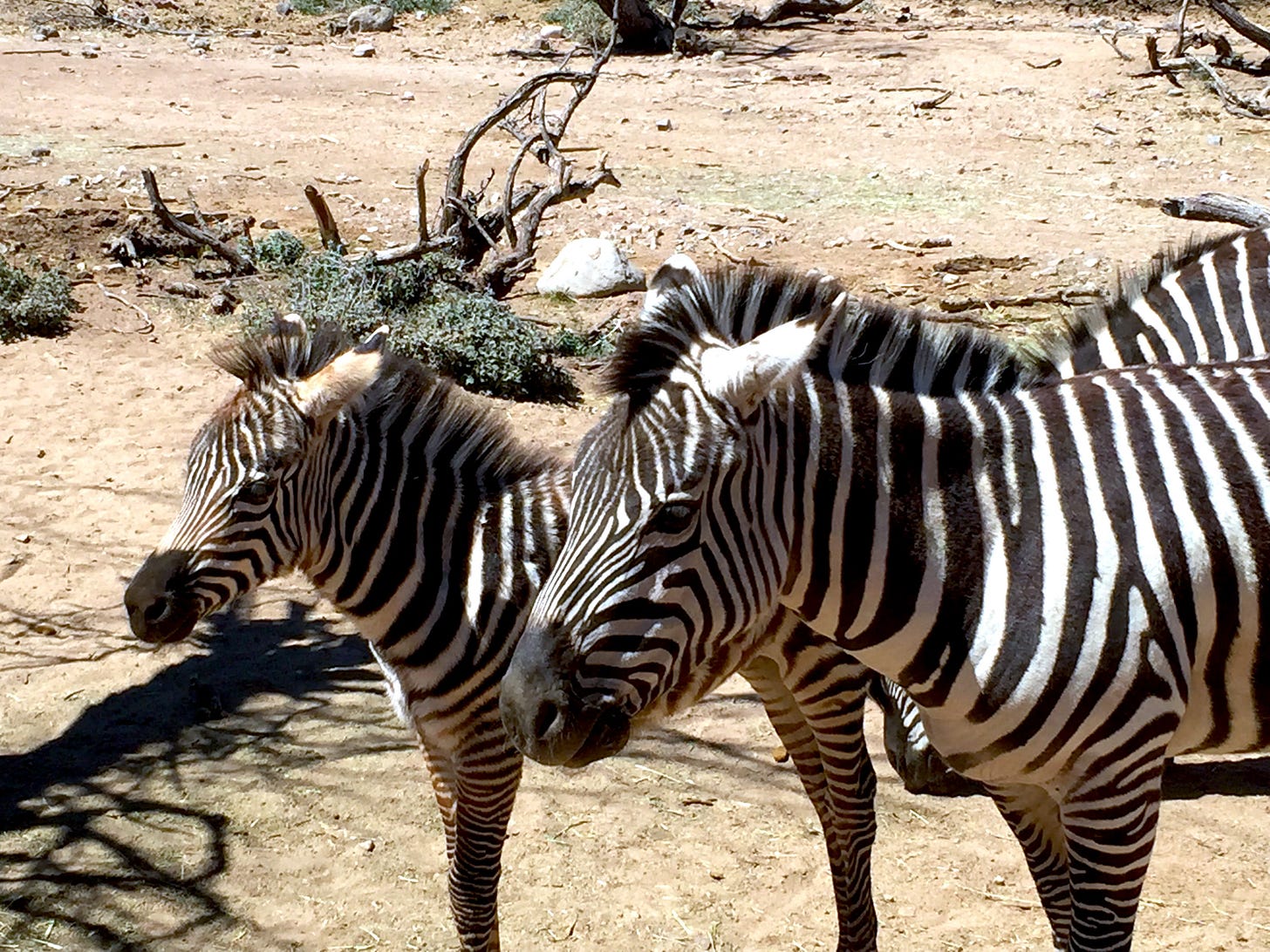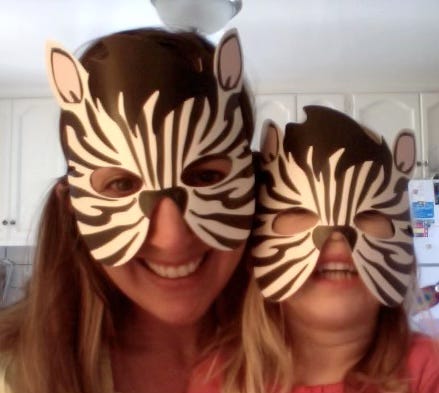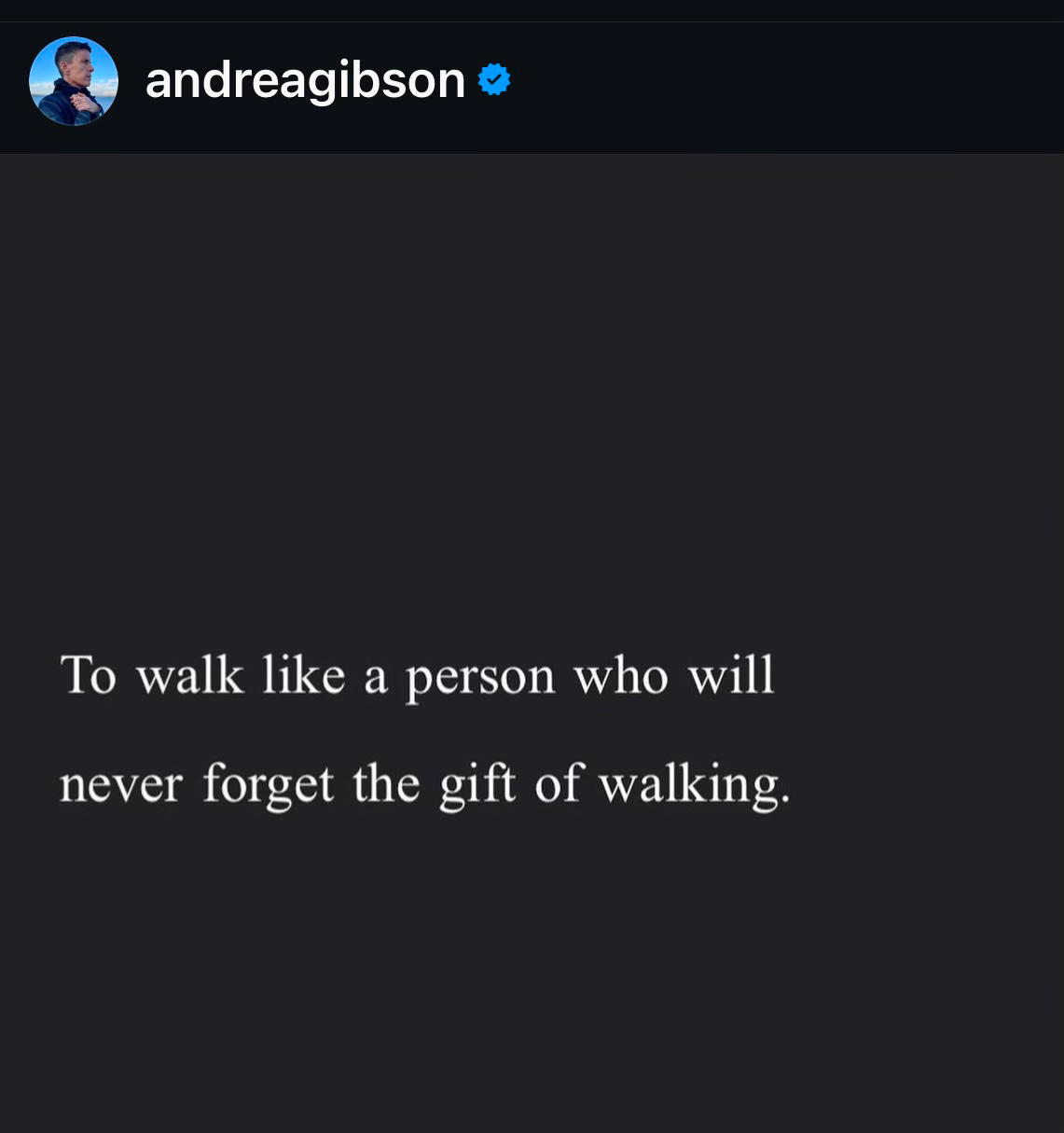i'm a zebra 🦓
for those with invisible illnesses or struggles
As I sit at my desk writing to you today, I have a knee brace on underneath my sweatpants. I’m relatively comfortable while sitting, so when I get up quickly to refill my water, it surprises me when I nearly fall over because of the intense pain that standing and walking elicits. However, by the time you’re reading this on Monday, I will be pain-free and out for a brisk and easy stroll. Sounds super weird, right?
I describe my unusual condition in Chapter 1 of my book, Midlife Emergence, by writing:
I had endured debilitating chronic pain since I was almost twenty-five years old, particularly in the form of severe knee inflammation. Inflammation literally means that there is an inner fire. (Clearly!) For decades, I had suffered cyclical bouts of intense knee swelling lasting for three out of every eleven days. I would wake up on the first day of the cycle with swollen balloons for knees. On what my family began to call “knee days,” I had a very difficult time getting up and down, walking for long distances, or doing any sort of exercise. I attempted to schedule my activities and commitments so they wouldn’t fall on “knee days.”
This wikipedia page is the closest description I've ever found to the symptoms I experience, but I still do not have a diagnosis. Sometimes the swelling is just in one knee, sometimes it alternates knees with each cycle, and right now as I’m writing this, it’s happening in both knees at once (which is rare, thankfully). I can’t find my second knee brace anywhere, so I just overnighted a new one.
For the first 15 years of feeling like this, Western medicine doctors poked, prodded, scanned, and then simply said, “Hmm, this is so strange…” I’ve been referred to a variety of specialists: orthopedic doctors, rheumatologists, endocrinologists, etc. Each specialist approached my case from the lens through which they practice and offered treatments only within their jurisdiction. This shortsighted method parses the body up into separate systems without acknowledging the body as a whole interdependent system. Infuriatingly, in my 20s and 30s, I was too often told, “This will pass — you’re young and healthy,” and figuratively patted on the head and sent away, limping.
I’ve done alllll the Eastern medicine approaches of acupuncture, Reiki, herbs, cupping… you name it. When I was nearly 40, I began working with a functional medicine practitioner. Over these past nine years, she has helped me get to the root of the issue. I now understand that the swollen knees are the symptom; the root is both autoimmune and viral. She’s helped me make huge strides in bolstering my immune system and regulating my hormones, offering some welcomed periods of relief from inflammation.
Over my adult life, I have experienced remission at mysterious times like for the three years I was in graduate school, when I was pregnant and breastfeeding my child, and when I began dating my girlfriend. In Chapter 10 of my book, I described how the pain curiously lifted as I aligned more with my inner truth:
Over the few years that followed, as I worked on freeing my inner fire, I became more liberated from the inflammation my body had suffered most of my adult life. Miraculously, my knee pain and swelling ceased suddenly and completely the week after that first piña colada date with Diana. I had been working with a functional medicine doctor for about four years, and after I was freed of pain for a few months, my doctor checked out my biofeedback information using my saliva. Without knowing the details of my personal life, she said, “From your biofeedback scan, it looks like you’re working on breaking emotional ties to past conditioning. Keep doing whatever it is you’re doing, because it’s healing your body more than any supplements I’ve been giving you.”
The pain stayed away during my and Diana’s first couple years of dating, until I got a COVID vaccine that triggered the same dreaded cycle for the next 18 months. After that (theoretically due to increased iron intake), it lifted again for two glorious years. It mysteriously returned this September.
So yeah, I’m a zebra. The zebra is the symbol for patients with rare diseases, or what many call mystery illnesses. The term "zebra" is a play on a phrase taught to medical students as a reminder to consider the most likely possibility first when making a diagnosis: "When you hear hoofbeats, think horses, not zebras.” [The EDS community has adopted this as its mascot, though the term is not specific to that particular illness.] Oddly, I’m kind of an invisible zebra, as I’ve hidden my illness by overriding my pain for so much of my life to “look normal.” Also, because it’s intermittent and not constant, people who have seen me on only the good days mistakingly think I’m able-bodied.
Last month, on the 24-year anniversary (yes, you read that right) of my first bout of swollen knees, I decided to begin another round of investigation with the allopathic community. Cue a million blood labs, thyroid medicine tweaks, X-rays, and a knee MRI — for which I had to pay a bunch of money — and it revealed… that I have inflammation in my knees. Big shocker!
I won’t bore you with more medical details, but I am finally compelled to write about my disability here. Publishing my book about “coming out” in midlife last year was a pretty widespread way to one to make the invisible visible. I get asked about my sexuality most often in interviews about my book, but it was also a coming out in so many facets of my life — my chronic pain being one of them. In midlife, I’ve realized how important it is to live in a way where my insides and outsides are congruent and where I’m visibly living and honoring my inner truth. I no longer push through my pain on knee days — I rest, and I ask for help (which is a topic that could be a whole other post).
wrote the quote below in their recent Substack post. (But gosh, please click to read the whole gorgeous and relatable post.):“There isn’t a healthy body in the world stronger than a sick person’s spirit. I believe that. But I also believe strength isn’t stoicism. Sometimes, strength is screaming. Or grieving out loud when the world tells you to be silent. Or crying openly in public. Sometimes strength is leaving the house when you want to stay in bed. Or making peace with staying in bed when you wish you were well enough to leave the house.”
If you are harboring an invisible illness, whether physical or mental, I feel you. It would also be wonderful to see you in all the strength it takes to bear it. If you are struggling with your mental health, I know both professionally and personally that mental health is very often invisible. Sadly, in our culture, mental health challenges aren’t treated like visible, physical health challenges, where one often receives compassion, meal trains, cards, phone calls, and “feel better” texts. I’ll leave you with a quote that we see so often that we might be desensitized to it or find it cheesy, but it is so wise and so true:
watching: The Happiest Season again, because we don’t have enough sapphic holiday movies
enjoying: wrapping holiday gifts in some unique, cozy wrapping paper I got from Society 6
oogling: my sparkly 🎄 tree every night. It legit makes me starry eyed 🤩 and smiley. 😊
looking forward to: the winter solstice + my 49th birthday this Saturday and a delicious staycation break for the holidays!
planning for: gathering with this new cohort of tender, badass women in midlife who have joined our Midlife Emergence Group Guidance circle beginning after the new year. (Psst: There are only a couple spots left. Is one of them yours?)
⭐️ Whether you’re an unpaid or paid subscriber to prism, having a spot in your inbox is an honor I don’t take for granted. It gives my art and writing a place to breathe. Thank you.











